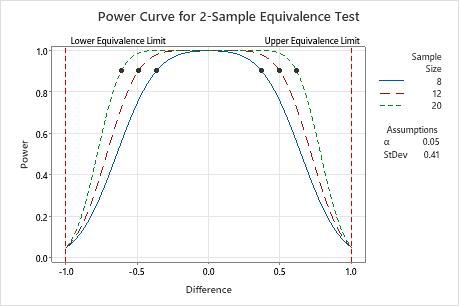Step 1: Examine the calculated values
- Difference (or ratio)
- If you enter the sample size and the power of the test, then Minitab calculates the difference (or ratio) that the test can accommodate at the specified power and sample size. For larger sample sizes, the difference (or ratio) can be closer to your equivalence limits. This value represents the difference (or ratio) between the mean of the test population and the mean of the reference population.
- Sample size
- If you enter a difference (or ratio) and a power value for the test, then Minitab calculates how large your sample must be. If you increase the sample size, the power of the test also increases. You want enough observations in your sample to achieve adequate power. But you don't want a sample size so large that you waste time and money on unnecessary sampling or detect unimportant differences to be statistically significant.
Note
Because sample sizes are whole numbers, the actual power of the test might be slightly greater than the power value that you specify.
- Power
- If you enter a sample size and a difference (or ratio), then Minitab calculates the power of the test. A power value of at least 0.9 is usually considered adequate. A power of 0.9 indicates that you have a 90% chance of demonstrating equivalence when the difference (or ratio) between the population means is actually within the equivalence limits. If an equivalence test has low power, you might fail to demonstrate equivalence even when the test mean and the reference mean are equivalent.Usually, when the sample size is smaller or when the difference (or ratio) is closer to an equivalence limit, the test has less power to claim equivalence.
Note
The definitions and interpretation in this topic apply to an equivalence test that uses the default alternative hypothesis for the difference (Lower limit < test mean - reference mean < upper limit or the default alternative hypothesis for the ratio (Lower limit < test mean / reference mean < upper limit).
Method
| Power for difference: | Test mean - reference mean |
|---|---|
| Null hypothesis: | Difference ≤ -1 or Difference ≥ 1 |
| Alternative hypothesis: | -1 < Difference < 1 |
| α level: | 0.05 |
| Assumed standard deviation: | 0.31 |
Results
| Difference | Sample Size | Power |
|---|---|---|
| 0.8 | 25 | 0.727010 |
Key Results: Difference, Sample size, Power
These results show that if the sample size is 25 in each group and the difference is 0.8, the power of the test to demonstrate equivalence is approximately 0.73. Because the power of the test is not adequate to accommodate a difference of 0.8, you should increase the sample size, if possible. You can also use the power curve to determine at what smaller difference value the test may achieve adequate power (0.9) with the specified sample size.
Step 2: Examine the power curve
Use the power curve to assess the appropriate sample size or power for your test.
The power curve represents every combination of power and difference (or ratio) for each sample size when the significance level and the standard deviation (or coefficient of variation) are held constant. Each symbol on the power curve represents a calculated value based on the values that you enter. For example, if you enter a sample size and a power value, Minitab calculates the corresponding difference (or ratio) and displays the calculated value on the graph.
Examine the values on the curve to determine the difference (or ratio) between the test mean and the reference mean that can be accommodated at a certain power value and sample size. A power value of 0.9 is usually considered adequate. However, some practitioners consider a power value of 0.8 to be adequate. If an equivalence test has low power, you might fail to demonstrate equivalence even when the population means are equivalent. If you increase the sample size, the power of the test also increases. You want enough observations in your sample to achieve adequate power. But you don't want a sample size so large that you waste time and money on unnecessary sampling or detect unimportant differences to be statistically significant. Usually, differences (or ratios) that are closer to the equivalence limits require more power to demonstrate equivalence.

In this graph, the power curve for a sample size of 8 (in each group) shows that the test has a power of 0.9 for a difference of approximately ±0.4. The power curve for a sample size of 12 shows that the test has a power of 0.9 for a difference of approximately ±0.5. The power curve for a sample size of 12 shows that the test has a power of 0.9 for a difference of approximately ±0.6. For each curve, as the difference approaches the lower equivalence limit or upper equivalence limit, the power of the test decreases and approaches α (alpha, which is the risk of claiming equivalence when it is not true).
